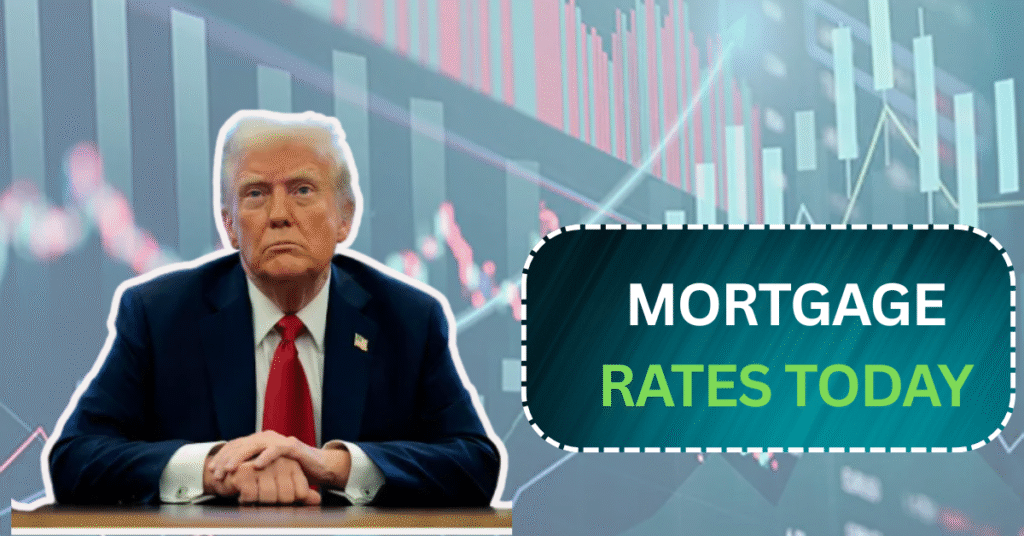On May 9, 2025, mortgage rates in the United States saw a slight decrease, offering a glimmer of hope for potential homebuyers. Although the days of historically low rates—ranging from 2% to 3%—are long gone, the current market remains accessible to financially prepared and proactive borrowers. This article will explore the current mortgage rates, factors affecting them, and what buyers should consider when navigating the housing market.
Mortgage Rates Today: What’s the Current Scenario?
Mortgage rates play a crucial role in determining the affordability of homeownership. Even a small change in interest rates can significantly impact monthly payments and the total amount paid over the life of the loan. For example, a 1% increase on a 30-year mortgage of $300,000 could lead to tens of thousands of dollars in additional interest.
As of today, the average 30-year fixed mortgage rate stands at 6.760%. This represents a minor decrease of 6 basis points from yesterday but remains slightly higher compared to last week. Mortgage rates have hovered around 7% for much of the past year, primarily due to economic instability and inflation concerns. While the Federal Reserve began relaxing its policies in 2024, the effect on mortgage rates has been limited.
For homebuyers, navigating this environment can be challenging, but there are still opportunities to secure reasonable terms, especially when negotiating with builders or shopping for favorable offers.
Factual Data on Mortgage Rates Today
| Loan Type | Current Rate | 1 Week Ago | 1 Month Ago |
| 30-year Conventional | 6.760% | 6.709% | 6.594% |
| 30-year Jumbo | 7.006% | 6.838% | 6.696% |
| 30-year FHA | 6.477% | 6.436% | 6.267% |
| 30-year VA | 6.324% | 6.282% | 6.109% |
| 30-year USDA | 6.479% | 6.374% | 6.314% |
| 15-year Conventional | 5.983% | 5.891% | 5.789% |
Key Factors Affecting Mortgage Interest Rates
Mortgage rates are influenced by various factors that borrowers should be aware of:
- Inflation:
Inflation is one of the primary drivers of mortgage rates. When inflation rises, lenders increase their rates to maintain their profit margins. This is because inflation erodes the purchasing power of money, and lenders need to adjust for the increased cost of funds. - Federal Reserve Policy:
The Federal Reserve (Fed) does not directly set mortgage rates, but its policies regarding interest rates and asset purchases have a significant impact on the mortgage market. When the Fed raises or lowers its benchmark interest rates, it indirectly influences mortgage rates across the economy. - Economic Environment:
The overall state of the economy—including GDP growth, consumer sentiment, and employment trends—can also affect mortgage rates. A growing economy can lead to higher demand for housing and loans, which may drive rates up. Conversely, a slowing economy might lead to lower rates. - National Debt:
The government’s level of borrowing can have an effect on mortgage rates as well. If national debt levels rise, it may lead to higher borrowing costs for consumers, including higher mortgage rates. - Supply and Demand:
In the housing market, demand for homes has a direct impact on mortgage rates. When demand is high, mortgage rates tend to rise, as lenders can charge more. On the other hand, when demand is low, mortgage rates may decrease in order to stimulate activity in the market.
Historical Chart of Mortgage Interest Rates
| Year | Average 30-Year Fixed Rate |
| 2021 (January) | 2.65% |
| 2022 | 5.50% |
| 2023 | 6.90% |
| 2024 | 6.60% |
| 2025 (May) | 6.76% |
| 1981 (Peak) | Over 18% |
Current Update on Mortgage Rates
While the rates today are slightly lower than yesterday, they still remain higher than the historically low rates seen during the pandemic. The “golden handcuffs” effect is a known situation in which homeowners who locked in ultra-low rates during 2020-2021 are reluctant to sell their homes. This reluctance to move has led to a tight housing inventory, further affecting the availability of homes for sale.
However, despite these challenges, the Federal Housing Administration (FHA), Veterans Affairs (VA), and U.S. Department of Agriculture (USDA) loans continue to make homeownership more accessible for eligible borrowers. These government-backed loans offer flexible terms and lower down payment requirements, easing the path to homeownership for those who qualify.
How to Get the Best Mortgage Rates
While securing the best mortgage rate today may seem challenging, there are steps buyers can take to increase their chances of getting favorable terms:
- Shop Around:
It’s essential to compare offers from multiple lenders. Don’t settle for the first rate you’re quoted. Different lenders offer varying terms, and even a small difference in the interest rate can result in significant savings over time. - Improve Your Credit Score:
Your credit score is one of the most important factors affecting your mortgage rate. The higher your credit score, the lower the interest rate you’re likely to receive. If possible, take time to improve your score before applying for a mortgage. - Consider a Larger Down Payment:
A larger down payment can help reduce your loan amount and may result in a lower interest rate. Lenders often offer better rates to borrowers who can make a substantial upfront payment. - Lock in Your Rate:
If you’re concerned about rising rates, consider locking in your mortgage rate with your lender. Many lenders offer rate locks for a set period, which can protect you from future increases. - Understand the Loan Terms:
Be sure to thoroughly understand the terms of your mortgage, including the interest rate, loan length, and any associated fees. Shorter-term loans typically come with lower interest rates, but monthly payments will be higher.
Conclusion
The mortgage rates today may not be as low as they were during the pandemic, but they are still within a reasonable range for those who are prepared and proactive in their home-buying journey. While various factors like inflation, Federal Reserve policies, and economic trends influence rates, buyers can still take steps to secure the best possible deal by shopping around, improving their credit score, and understanding their loan options.




